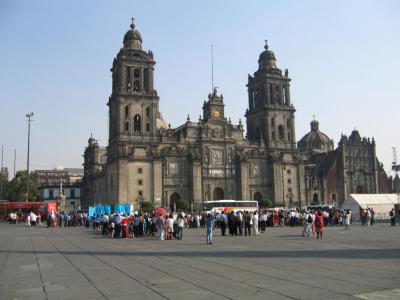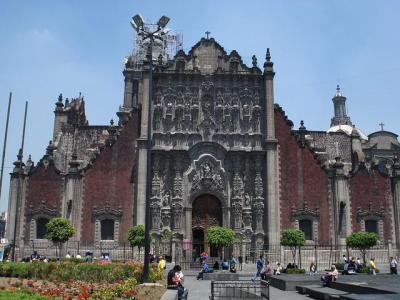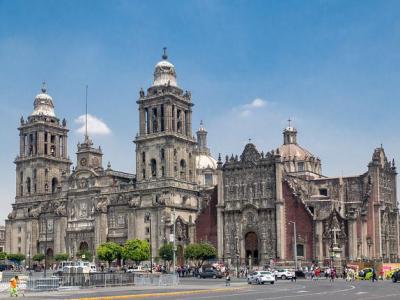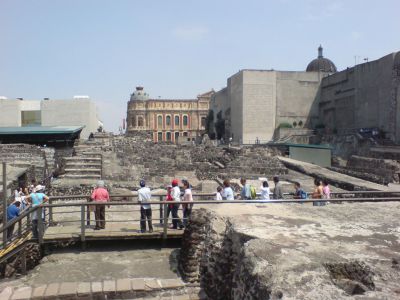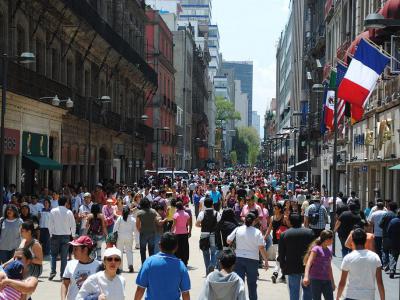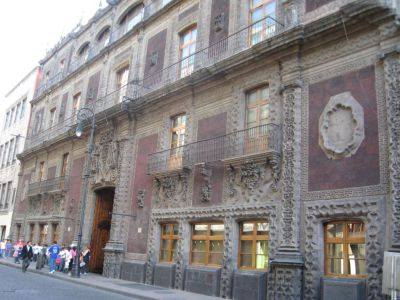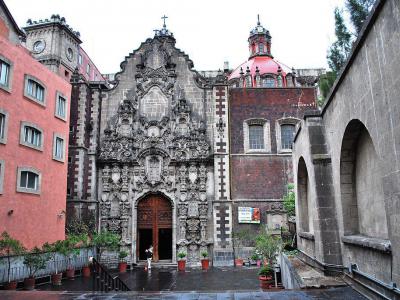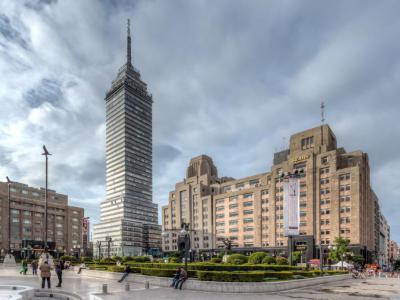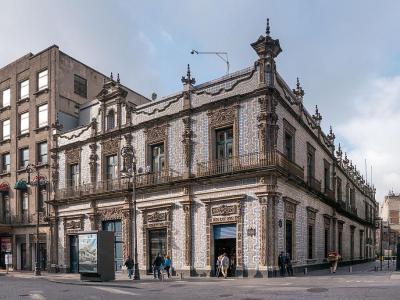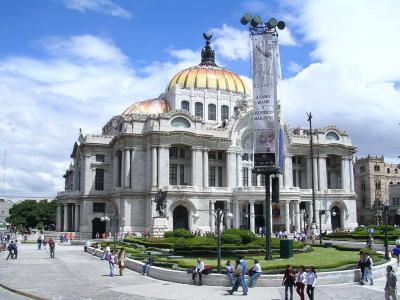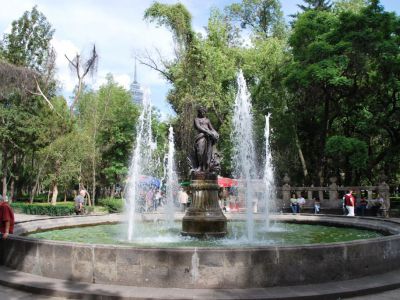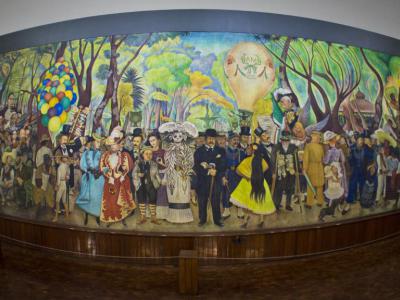Audio Guide: Historic Center Walking Tour (Self Guided), Mexico City
Mexico City is the oldest capital in the Americas and is one of the two founded by indigenous people. Originally known as Mexico Tenochtitlan, the city was built by the Mexicas (aka Aztecs) in 1325. According to a legend, the Mexicas' principal god, Huitzilopochtli, pointed out the site of the future settlement with an image of a golden eagle perched on a prickly pear cactus, devouring a rattlesnake.
After their Conquest, in the early 1500s, the Spaniards started to build Mexico City on the ruins of the conquered Tenochtitlan, often using for their construction the stones from the fallen Mexica temples. Whilst at it, they retained the original layout of the city pretty much intact. In the 17th and 18th centuries, the conquistadors accumulated great fortunes, mostly through mining and commerce. This wealth is now manifested in the multiple mansions, such as the House of Tiles (Casa de Azulejos), abounding in the downtown area.
Nowadays, the historic heart of Mexico City (Centro Histórico de la Ciudad de México) still roughly correlates with the ancient Tenochtitlan, revealing pre-Colombian heritage embedded in the street grid, locations' names, and architecture.
The vast majority of historic sites, such as a large number of museums, are found in the central part of the city – a World Heritage Site since 1987. This area is centered around the massive Zócalo plaza, formally known as Constitution Square (Plaza de la Constitución). Apart from being the city's main square, it is also the largest square in Latin America. From here, the historic center extends for several blocks in all directions, reaching as far as Alameda Central Park in the west.
Other key local landmarks include the Baroque-style Metropolitan Cathedral (Catedral Metropolitana) and the National Palace (Palacio Nacional), the seat of the country's president, adorned with Diego Rivera's murals depicting pre-Hispanic life and the history of the Mexican nation after the Conquest. Here, you will also find the iconic art nouveau Palace of Fine Arts (Palacio de Bellas Artes) and the Great Temple (Templo Mayor) archaeological site.
The bustling thoroughfare Madero Street (Calle Madero), cutting through the city center, is yet another attraction. This street accommodates a multitude of street vendors and taco restaurants (taquerías) coexisting harmoniously with high-end establishments. It is also home to the majestic Palace of Iturbide, the former residence of the country's first emperor.
The Latin-American Tower (Torre Latinoamericana) is a modern addition to the cityscape and one of the best-known skyscrapers in Latin America; completed in 1956.
To explore these and other top attractions in the ancient yet perpetually vibrant historic heart of the Mexican capital, take this self-guided walking tour!
After their Conquest, in the early 1500s, the Spaniards started to build Mexico City on the ruins of the conquered Tenochtitlan, often using for their construction the stones from the fallen Mexica temples. Whilst at it, they retained the original layout of the city pretty much intact. In the 17th and 18th centuries, the conquistadors accumulated great fortunes, mostly through mining and commerce. This wealth is now manifested in the multiple mansions, such as the House of Tiles (Casa de Azulejos), abounding in the downtown area.
Nowadays, the historic heart of Mexico City (Centro Histórico de la Ciudad de México) still roughly correlates with the ancient Tenochtitlan, revealing pre-Colombian heritage embedded in the street grid, locations' names, and architecture.
The vast majority of historic sites, such as a large number of museums, are found in the central part of the city – a World Heritage Site since 1987. This area is centered around the massive Zócalo plaza, formally known as Constitution Square (Plaza de la Constitución). Apart from being the city's main square, it is also the largest square in Latin America. From here, the historic center extends for several blocks in all directions, reaching as far as Alameda Central Park in the west.
Other key local landmarks include the Baroque-style Metropolitan Cathedral (Catedral Metropolitana) and the National Palace (Palacio Nacional), the seat of the country's president, adorned with Diego Rivera's murals depicting pre-Hispanic life and the history of the Mexican nation after the Conquest. Here, you will also find the iconic art nouveau Palace of Fine Arts (Palacio de Bellas Artes) and the Great Temple (Templo Mayor) archaeological site.
The bustling thoroughfare Madero Street (Calle Madero), cutting through the city center, is yet another attraction. This street accommodates a multitude of street vendors and taco restaurants (taquerías) coexisting harmoniously with high-end establishments. It is also home to the majestic Palace of Iturbide, the former residence of the country's first emperor.
The Latin-American Tower (Torre Latinoamericana) is a modern addition to the cityscape and one of the best-known skyscrapers in Latin America; completed in 1956.
To explore these and other top attractions in the ancient yet perpetually vibrant historic heart of the Mexican capital, take this self-guided walking tour!
How it works: Download the app "GPSmyCity: Walks in 1K+ Cities" from Apple App Store or Google Play Store to your mobile phone or tablet. The app turns your mobile device into a personal tour guide and its built-in GPS navigation functions guide you from one tour stop to next. The app works offline, so no data plan is needed when traveling abroad.
Historic Center Walking Tour Map
Guide Name: Historic Center Walking Tour
Guide Location: Mexico » Mexico City (See other walking tours in Mexico City)
Guide Type: Self-guided Walking Tour (Sightseeing)
# of Attractions: 13
Tour Duration: 2 Hour(s)
Travel Distance: 2.7 Km or 1.7 Miles
Author: doris
Sight(s) Featured in This Guide:
Guide Location: Mexico » Mexico City (See other walking tours in Mexico City)
Guide Type: Self-guided Walking Tour (Sightseeing)
# of Attractions: 13
Tour Duration: 2 Hour(s)
Travel Distance: 2.7 Km or 1.7 Miles
Author: doris
Sight(s) Featured in This Guide:
- Zocalo (Constitution Square)
- Palacio Nacional (National Palace)
- Sagrario Metropolitano (Metropolitan Tabernacle)
- Catedral Metropolitana (Metropolitan Cathedral)
- Templo Mayor (The Great Temple)
- Calle Madero (Madero Street)
- Palacio de Iturbide (Iturbide Palace)
- Iglesia de San Francisco (Church of San Francisco)
- Torre Latinoamericana (Latin-American Tower)
- Casa de Azulejos (House of Tiles) / Sanborns Cafe
- Palacio de Bellas Artes (Palace of Fine Arts)
- Alameda Central Park
- Museo Mural de Diego Rivera (Diego Rivera Mural Museum)
1) Zocalo (Constitution Square) (must see)
Formally known as Constitution Square (Plaza de la Constitución), this is one of Mexico City's most historically and culturally intriguing destinations. The central square of the Mexican capital is also one of the largest public squares in the world, measuring 57,600 square meters and capable of holding up to 100,000 people at once!
Previously called Arms Square (Plaza de Armas) or Main Square (Plaza Principal), it is nowadays more commonly referred to as El Zócalo, which means "the plinth". This nickname was adopted in the 19th century and refers to the monument intended to be erected in the plaza, but never materialized (apart from its plinth). While the plinth is long gone now, the name stuck.
The grand square was established circa the 14th century AD and once served as a ceremonial hub of the Aztec city, Tenochtitlán; it was also a major marketplace. The historic spot that we see today started to take shape in the post-colonization period, thanks to the architectural efforts of Alonso García Bravo, a Spanish mercenary who took part in the Conquest of Mexico and was also a master builder and urban planner.
Throughout much of the 17th century, the plaza was overrun with market stalls. In the 1860s, Emperor Maximilian I expelled all merchants from the area; however, from the latter half of the 19th century to the early 20th, it was once again filled with market activity.
In 1914, the plaza was cleared of all the ash trees planted during the previous century and turned into a Parisian-style park, with tree-lined walkways, benches, and grassy areas. Also, each corner of the plaza was fitted with palm trees.
What was previously dominated by the looming silhouettes of Tenochtitlan's temples and pyramids, such as the Great Temple, today is ringed by similarly emblematic buildings like the Metropolitan Cathedral, the National Palace, the National Museum of Arts, and the House of Tiles.
A giant Mexican flag (ceremoniously lowered every evening, at six o'clock) enjoys the pride of place in the center of the plaza. In the heat of the day, you can see crowds of people taking shelter in the flagpole's shade. Concerts, street shows, public gatherings, as well as a massive ice rink (in December) are among the regular things to watch for in the Zócalo.
Tip:
Amid the lack of shade, the square often feels like a hell's kitchen, so consider opting for a cooler part of the day for maximum enjoyment. Alternatively, you can go up to the Hotel Gran Ciudad de México's terrace for a great photo op, or have lunch at Balcón del Zócalo, a rooftop restaurant in the Zócalo Central Hotel, which offers gorgeous views of the plaza.
Previously called Arms Square (Plaza de Armas) or Main Square (Plaza Principal), it is nowadays more commonly referred to as El Zócalo, which means "the plinth". This nickname was adopted in the 19th century and refers to the monument intended to be erected in the plaza, but never materialized (apart from its plinth). While the plinth is long gone now, the name stuck.
The grand square was established circa the 14th century AD and once served as a ceremonial hub of the Aztec city, Tenochtitlán; it was also a major marketplace. The historic spot that we see today started to take shape in the post-colonization period, thanks to the architectural efforts of Alonso García Bravo, a Spanish mercenary who took part in the Conquest of Mexico and was also a master builder and urban planner.
Throughout much of the 17th century, the plaza was overrun with market stalls. In the 1860s, Emperor Maximilian I expelled all merchants from the area; however, from the latter half of the 19th century to the early 20th, it was once again filled with market activity.
In 1914, the plaza was cleared of all the ash trees planted during the previous century and turned into a Parisian-style park, with tree-lined walkways, benches, and grassy areas. Also, each corner of the plaza was fitted with palm trees.
What was previously dominated by the looming silhouettes of Tenochtitlan's temples and pyramids, such as the Great Temple, today is ringed by similarly emblematic buildings like the Metropolitan Cathedral, the National Palace, the National Museum of Arts, and the House of Tiles.
A giant Mexican flag (ceremoniously lowered every evening, at six o'clock) enjoys the pride of place in the center of the plaza. In the heat of the day, you can see crowds of people taking shelter in the flagpole's shade. Concerts, street shows, public gatherings, as well as a massive ice rink (in December) are among the regular things to watch for in the Zócalo.
Tip:
Amid the lack of shade, the square often feels like a hell's kitchen, so consider opting for a cooler part of the day for maximum enjoyment. Alternatively, you can go up to the Hotel Gran Ciudad de México's terrace for a great photo op, or have lunch at Balcón del Zócalo, a rooftop restaurant in the Zócalo Central Hotel, which offers gorgeous views of the plaza.
2) Palacio Nacional (National Palace) (must see)
Stretching for over 200 meters (660 feet) across the entire east side of the Zócalo is the National Palace (Palacio Nacional), the official residence of the President of Mexico. Renowned for its grand red facade, made of volcanic rock called tezontle, this place has been the seat of a ruling class since the pre-Hispanic era. Much of the construction material for the current building was taken from the original palace of the 16th-century Aztec Emperor, Moctezuma II, which stood on this site and whose richness surprised the Spanish upon their arrival.
During the Conquest, the old palace wasn't completely destroyed. In the 1520s, Hernán Cortés built on its ruins a massive fortress which later became the official home for Spanish viceroys governing the colonies. The Spanish crown bought the property from the Cortés family in 1562 and thence called it the Palace of the Viceroy (Palacio del Virrey).
After the Mexican War of Independence in the 1820s, the building was renamed the "National Palace" and underwent structural changes. For a brief period, it was occupied by the country's two self-proclaimed emperors, Agustin de Iturbide and Maximilian I, and later became home to the first president of Mexico, Guadalupe Victoria.
The original church bell from the town of Dolores Hidalgo in Guanajuato state (once used to call for a rebellion against Spain in 1810) is now hung over the palace's main balcony. Each year, on Independence Day, September 15th, the president of Mexico rings the Dolores Bell in commemoration of that event.
The Palace has fourteen courtyards, of which only a few, like the Grand Courtyard, are open to the public. Here, the main stairwell and the walls (on the second floor) are adorned with murals by Diego Rivera, depicting the history of Mexico from 1521 to 1930, jointly titled "The Epic of the Mexican People".
Painted between 1929 and 1935, the work is presented in the form of a triptych, with the right-hand murals featuring pre-Hispanic Mexico centered around the life of the Aztec god Quetzalcóatl. The most extensive panel, in the middle, called the Conquest, showcases the sufferings endured by the indigenous people. The one on the left-hand side is dedicated to the early and mid-20th century, depicting a Marxist kind of utopia and featuring, among other persons, Diego's wife, Frida Kahlo.
Tip:
Since this is a government building, in order to get in you need to produce either a valid driver's license or passport. Bags, bottled water, hats, and sunglasses are not allowed.
During the Conquest, the old palace wasn't completely destroyed. In the 1520s, Hernán Cortés built on its ruins a massive fortress which later became the official home for Spanish viceroys governing the colonies. The Spanish crown bought the property from the Cortés family in 1562 and thence called it the Palace of the Viceroy (Palacio del Virrey).
After the Mexican War of Independence in the 1820s, the building was renamed the "National Palace" and underwent structural changes. For a brief period, it was occupied by the country's two self-proclaimed emperors, Agustin de Iturbide and Maximilian I, and later became home to the first president of Mexico, Guadalupe Victoria.
The original church bell from the town of Dolores Hidalgo in Guanajuato state (once used to call for a rebellion against Spain in 1810) is now hung over the palace's main balcony. Each year, on Independence Day, September 15th, the president of Mexico rings the Dolores Bell in commemoration of that event.
The Palace has fourteen courtyards, of which only a few, like the Grand Courtyard, are open to the public. Here, the main stairwell and the walls (on the second floor) are adorned with murals by Diego Rivera, depicting the history of Mexico from 1521 to 1930, jointly titled "The Epic of the Mexican People".
Painted between 1929 and 1935, the work is presented in the form of a triptych, with the right-hand murals featuring pre-Hispanic Mexico centered around the life of the Aztec god Quetzalcóatl. The most extensive panel, in the middle, called the Conquest, showcases the sufferings endured by the indigenous people. The one on the left-hand side is dedicated to the early and mid-20th century, depicting a Marxist kind of utopia and featuring, among other persons, Diego's wife, Frida Kahlo.
Tip:
Since this is a government building, in order to get in you need to produce either a valid driver's license or passport. Bags, bottled water, hats, and sunglasses are not allowed.
3) Sagrario Metropolitano (Metropolitan Tabernacle)
Situated to the right of the Metropolitan Cathedral is the Metropolitan Tabernacle (Sagrario Metropolitano). Built between 1749 and 1760, it is considered a masterpiece of the Churrigueresque Baroque architecture. The structure has a Greek-cross plan and was purposed to house the archives and vestments of the archbishop; it also functioned, and still does, as a place to receive Eucharist and register parishioners.
The tabernacle has two main entrances; one to the south, facing the Zócalo, and the other facing east toward Seminario Street. The porous volcanic rock – tezontle – responsible for the deep-red color is beautifully contrasted by the white stone carvings adorning the exterior.
The southern (main) façade is richly decorated. Here, alongside the carvings of grapes and pomegranates as the ritual offerings symbolizing the Blood of Christ and the Church, you can see the images of apostles, saints, and martyrs, as well as scenes from the Bible and some zoomorphic reliefs, like a rampaging lion and the eagle from the coat of arms of Mexico. The eastern façade, somewhat less elaborate, contains images from the Old Testament and some prominent religious figures like Ignacio de Loyola, founder of the Jesuit order.
The Tabernacle stands on the site of a drained lake and its foundations are slowly sinking because of the unstable subsoil. Efforts are currently underway to stabilize the building and other nearby structures.
The tabernacle has two main entrances; one to the south, facing the Zócalo, and the other facing east toward Seminario Street. The porous volcanic rock – tezontle – responsible for the deep-red color is beautifully contrasted by the white stone carvings adorning the exterior.
The southern (main) façade is richly decorated. Here, alongside the carvings of grapes and pomegranates as the ritual offerings symbolizing the Blood of Christ and the Church, you can see the images of apostles, saints, and martyrs, as well as scenes from the Bible and some zoomorphic reliefs, like a rampaging lion and the eagle from the coat of arms of Mexico. The eastern façade, somewhat less elaborate, contains images from the Old Testament and some prominent religious figures like Ignacio de Loyola, founder of the Jesuit order.
The Tabernacle stands on the site of a drained lake and its foundations are slowly sinking because of the unstable subsoil. Efforts are currently underway to stabilize the building and other nearby structures.
4) Catedral Metropolitana (Metropolitan Cathedral) (must see)
Dominating the Zócalo to the north is the Metropolitan Cathedral, the oldest and largest European church in the Western Hemisphere. The temple sits on the site of the former Aztec sacred precinct, the palace of Moctezuma, destroyed during the Spanish conquest.
The cathedral's first stone was laid in 1553, set to replace the modest church built in this place in 1524. The whole building took nearly 250 years to complete, from 1573 to 1813, over which period numerous architects, sculptors, and painters worked on it, bringing in a dazzling array of styles (Gothic, Baroque, Neoclassical, Renaissance, and even Churrigueresque) and diverse decorations. An exceptional collection of paintings, statues, and glittering altarpieces found inside the cathedral are complemented by the largest in the Americas 18th-century organs (nowadays frequently used in musical concerts).
A mortar-and-stone symbol of Catholicism in Mexico's life, this cathedral was often at the epicenter of historically important events, such as the coronation of Agustín de Iturbide and Ana María Huarte as the first emperors of Mexico in 1822, and many others.
Throughout its long life, the cathedral suffered multiple damages. During the earthquake on September 19, 2017, a cross known as La Esperanza, which used to crown one of the two belfries, toppled and fell to the ground. The spot where it landed is now an attraction in its own right.
Tip:
Since this is a functioning cathedral, make sure to avoid mass hours.
Walk down the sloping floor from the altar towards the back of the church, and look for the large pendulum suspended from the ceiling which tracks how much the building has sunk (due to the soft clay subsoil on which it stands) by marking a record on the floor. Also, check out the doorways and columns to see how the church is leaning.
Don't miss the Black Jesus (aka the "Lord of Poison") statue in the chapel at the back (you may want to read in advance to see why it's famous).
The cathedral's first stone was laid in 1553, set to replace the modest church built in this place in 1524. The whole building took nearly 250 years to complete, from 1573 to 1813, over which period numerous architects, sculptors, and painters worked on it, bringing in a dazzling array of styles (Gothic, Baroque, Neoclassical, Renaissance, and even Churrigueresque) and diverse decorations. An exceptional collection of paintings, statues, and glittering altarpieces found inside the cathedral are complemented by the largest in the Americas 18th-century organs (nowadays frequently used in musical concerts).
A mortar-and-stone symbol of Catholicism in Mexico's life, this cathedral was often at the epicenter of historically important events, such as the coronation of Agustín de Iturbide and Ana María Huarte as the first emperors of Mexico in 1822, and many others.
Throughout its long life, the cathedral suffered multiple damages. During the earthquake on September 19, 2017, a cross known as La Esperanza, which used to crown one of the two belfries, toppled and fell to the ground. The spot where it landed is now an attraction in its own right.
Tip:
Since this is a functioning cathedral, make sure to avoid mass hours.
Walk down the sloping floor from the altar towards the back of the church, and look for the large pendulum suspended from the ceiling which tracks how much the building has sunk (due to the soft clay subsoil on which it stands) by marking a record on the floor. Also, check out the doorways and columns to see how the church is leaning.
Don't miss the Black Jesus (aka the "Lord of Poison") statue in the chapel at the back (you may want to read in advance to see why it's famous).
5) Templo Mayor (The Great Temple) (must see)
A massive pyramid temple in the heart of the Tenochtitlán empire, the Great Temple (Templo Mayor) was once the crown jewel and the absolute center of the Mexica world before the Spanish conquest. First built around 1325, the structure stood almost 60 meters high and had dual staircases leading up to the two crowning temples, one dedicated to Huitzilopochtli, the god of sun and war, and the other to Tlaloc, the god of rain and agriculture.
After the Spanish conquered the city, the Temple was razed, but some of its traces remained. On February 21, 1978, electric company workers digging near the Metropolitan Cathedral uncovered an eight-ton monolith adorned with the carvings of the moon goddess Coyolxauhqui. The discovery prompted a major excavation during which four city blocks were demolished and the base of the Temple was revealed, along with multiple artifacts. In 2017, the space was further expanded to unearth partial remains of a round temple dedicated to the god Ehécatl, which is now open to the public.
The Aztec ruin of such magnitude is rather unique and includes traces of seven pyramids, as well as the Eagle Warrior Temple.
The adjoining eight-room museum showcases an extensive collection of pre-Colombian artifacts found on the site and is well worth two-four hours of your time, depending on your level of interest in Aztec religion, culture, and symbolism.
Tip:
The outside part can get very hot. Make sure to wear a hat and stay hydrated, or avoid the midday sun. If wishing to climb the Pyramid of the Sun, head there first because long lines can form early.
If you are not a Spanish speaker, check if there are audio guides available, because aside from some signage, most of the museum's text content is not translated into other languages.
Visitors can make reservations for a guided tour in English.
After the Spanish conquered the city, the Temple was razed, but some of its traces remained. On February 21, 1978, electric company workers digging near the Metropolitan Cathedral uncovered an eight-ton monolith adorned with the carvings of the moon goddess Coyolxauhqui. The discovery prompted a major excavation during which four city blocks were demolished and the base of the Temple was revealed, along with multiple artifacts. In 2017, the space was further expanded to unearth partial remains of a round temple dedicated to the god Ehécatl, which is now open to the public.
The Aztec ruin of such magnitude is rather unique and includes traces of seven pyramids, as well as the Eagle Warrior Temple.
The adjoining eight-room museum showcases an extensive collection of pre-Colombian artifacts found on the site and is well worth two-four hours of your time, depending on your level of interest in Aztec religion, culture, and symbolism.
Tip:
The outside part can get very hot. Make sure to wear a hat and stay hydrated, or avoid the midday sun. If wishing to climb the Pyramid of the Sun, head there first because long lines can form early.
If you are not a Spanish speaker, check if there are audio guides available, because aside from some signage, most of the museum's text content is not translated into other languages.
Visitors can make reservations for a guided tour in English.
6) Calle Madero (Madero Street)
Francisco I. Madero Avenue, commonly known as simply Madero Street (Calle Madero), is a major thoroughfare in the historic center of Mexico City. This was one of the first streets to be laid out by the Spaniards in the 16th century, following the destruction of the Aztec capital Tenochtitlán.
The street was originally called San Francisco Street, after the church and monastery here. Later, three sections of it each had their own name. The Western half was called "First and Second Street of San Francisco". The section further East was known as "Profesa street" after the Temple of San Felipe Neri (commonly known as "La Profesa") there, and the section between Isabel la Católica street and the Zócalo was known as "Silversmith's road" (Calle de Plateros) after the silver jewelry workshops and stores established in that area in the 17th century.
The street's current name honors one of the key figures of the Mexican Revolution – Francisco I. Madero, who briefly served as the president of the country before his assassination in 1913. Francisco "Pancho" Villa, the revolution general, who fixed a plaque with the new street name for the first time in 1914, announced that whoever dared to remove it would be shot!
From the very beginning, the street was one of the most popular and busiest roads. The centrality of its location, both geographically and culturally, made it the most desirable destination to live in.
Among the key standouts here are: the 18th-century Palace of Iturbide, the vestige of the brief reign of the self-proclaimed emperor of Mexico, Agustín de Iturbide; the 16th-century Church of San Francisco – once part of the largest convent in New Spain; the Torre Latinoamericana skyscraper; and the unmistakably iconic, blue-and-white-tiled House of Tiles.
As of 2009, the street has been pedestrianized. The change proved successful, bringing in crowds of pedestrians, making it a people-watching heaven, and increasing the value of local real estate.
Tip:
For authentic gifts, clothing, and accessories – all made in Mexico, fairly priced, and of adequate quality – check out the hip HAPPENING store at #10C (Open Mon-Fri: 12–8 pm; Sat: 11–8 pm; Sun: 11–6 pm).
The street was originally called San Francisco Street, after the church and monastery here. Later, three sections of it each had their own name. The Western half was called "First and Second Street of San Francisco". The section further East was known as "Profesa street" after the Temple of San Felipe Neri (commonly known as "La Profesa") there, and the section between Isabel la Católica street and the Zócalo was known as "Silversmith's road" (Calle de Plateros) after the silver jewelry workshops and stores established in that area in the 17th century.
The street's current name honors one of the key figures of the Mexican Revolution – Francisco I. Madero, who briefly served as the president of the country before his assassination in 1913. Francisco "Pancho" Villa, the revolution general, who fixed a plaque with the new street name for the first time in 1914, announced that whoever dared to remove it would be shot!
From the very beginning, the street was one of the most popular and busiest roads. The centrality of its location, both geographically and culturally, made it the most desirable destination to live in.
Among the key standouts here are: the 18th-century Palace of Iturbide, the vestige of the brief reign of the self-proclaimed emperor of Mexico, Agustín de Iturbide; the 16th-century Church of San Francisco – once part of the largest convent in New Spain; the Torre Latinoamericana skyscraper; and the unmistakably iconic, blue-and-white-tiled House of Tiles.
As of 2009, the street has been pedestrianized. The change proved successful, bringing in crowds of pedestrians, making it a people-watching heaven, and increasing the value of local real estate.
Tip:
For authentic gifts, clothing, and accessories – all made in Mexico, fairly priced, and of adequate quality – check out the hip HAPPENING store at #10C (Open Mon-Fri: 12–8 pm; Sat: 11–8 pm; Sun: 11–6 pm).
7) Palacio de Iturbide (Iturbide Palace)
The massive Baroque mansion, richly adorned with intricate sandstone carvings around the windows and door frames, at Madero Street #17, is the former residence of Miguel de Berrio y Saldívar, a rich nobleman and direct descendant of Spanish conquistadors, as well as a one-time mayor of Mexico City.
This palatial property is a replica of the royal palace in Palermo and was built between 1779 and 1785 to a design by Francisco Antonio Guerrero y Torres. The owner purportedly built this house as an elaborate equivalent to his daughter's dowry (worth 100,000 pesos, a huge sum at that time) in a bid to prevent his new son-in-law, Marquis of Moncada of Sicily, from squandering his daughter's wealth.
The couple's son, though, opted not to live here but offered the palace for accommodating visiting dignitaries. One such was Agustín de Iturbide. It was from this palace's balcony that Iturbide accepted the offer to become Mexico's first emperor after the proclamation of independence from Spain. During his short reign, from 1821 to 1823, Iturbide used this house as the royal residence, subsequently giving it the popular name.
Early in the 19th century, the building housed the College of Mining, and in 1855 was remodeled into a hotel (in which capacity it served for another 100+ years).
In 1965, the building was purchased and restored by the National Bank of Mexico. In 1972, it became the home of the Banamex Cultural Foundation (Fomento Cultural Banamex) which is dedicated to the promotion of Mexican art. It was officially inaugurated as the Palace of Culture (Palacio de Cultura) Banamex in 2004.
Tip:
Browse at the small but well-appointed on-site bookshop (some of the items on sale here may be high-priced, but are great to look at).
This palatial property is a replica of the royal palace in Palermo and was built between 1779 and 1785 to a design by Francisco Antonio Guerrero y Torres. The owner purportedly built this house as an elaborate equivalent to his daughter's dowry (worth 100,000 pesos, a huge sum at that time) in a bid to prevent his new son-in-law, Marquis of Moncada of Sicily, from squandering his daughter's wealth.
The couple's son, though, opted not to live here but offered the palace for accommodating visiting dignitaries. One such was Agustín de Iturbide. It was from this palace's balcony that Iturbide accepted the offer to become Mexico's first emperor after the proclamation of independence from Spain. During his short reign, from 1821 to 1823, Iturbide used this house as the royal residence, subsequently giving it the popular name.
Early in the 19th century, the building housed the College of Mining, and in 1855 was remodeled into a hotel (in which capacity it served for another 100+ years).
In 1965, the building was purchased and restored by the National Bank of Mexico. In 1972, it became the home of the Banamex Cultural Foundation (Fomento Cultural Banamex) which is dedicated to the promotion of Mexican art. It was officially inaugurated as the Palace of Culture (Palacio de Cultura) Banamex in 2004.
Tip:
Browse at the small but well-appointed on-site bookshop (some of the items on sale here may be high-priced, but are great to look at).
8) Iglesia de San Francisco (Church of San Francisco)
The church of San Francisco is all that remains of what was once the largest and most influential convent in Mexico City. The sanctuary was established as the headquarters of the first twelve Franciscan friars who came to Mexico after receiving authorization from the Pope to evangelize in New Spain. At its peak, during the colonial period, the monastery complex included chapels, outbuildings, a hospital, and orchards, and comprised a total area of more than 30,000 square meters.
Curiously enough, during pre-Colombian times, this part of the city was occupied by the animal house, a kind of zoo of the Aztec Emperor, Moctezuma II.
The current church on the site is the third one, built between 1710 and 1716. Its two predecessors fell victim to the soft soil underneath and had to be torn down. Although the entire building is known as the San Francisco Church, the actual site on Madero Street is the Balvanera Chapel. To get inside the church one has to walk downstairs quite a few steps because, unfortunately, the building has sunk considerably. For this reason, its main facade is walled in and cannot be seen. Thus, the only way in is via the Balvanera Chapel on the side.
The facade of the chapel dates back to 1766 and is attributed to Lorenzo Rodríguez, best known for his work on the Metropolitan Tabernacle. Inside is an 18th-century altarpiece dedicated to the Virgin of Guadalupe and the entrance to what was once the Chapel of the Second Station of the Stations of the Cross.
Both the church and the monastery saw a number of historic events in their time. One such was the funeral mass for Hernán Cortés after they thought he was dead in Central America. Following the Reform War of 1858-1861, the monastery of San Francisco, like many others, was disbanded and most of its property was seized by the government. Eventually, much of the monastery was demolished for the construction of new roads. Other parts have survived, proving more expensive to be demolished than to be left standing.
As you explore Centro Histórico, make sure to mark this on your map as an important milestone of the Mexican faith.
Curiously enough, during pre-Colombian times, this part of the city was occupied by the animal house, a kind of zoo of the Aztec Emperor, Moctezuma II.
The current church on the site is the third one, built between 1710 and 1716. Its two predecessors fell victim to the soft soil underneath and had to be torn down. Although the entire building is known as the San Francisco Church, the actual site on Madero Street is the Balvanera Chapel. To get inside the church one has to walk downstairs quite a few steps because, unfortunately, the building has sunk considerably. For this reason, its main facade is walled in and cannot be seen. Thus, the only way in is via the Balvanera Chapel on the side.
The facade of the chapel dates back to 1766 and is attributed to Lorenzo Rodríguez, best known for his work on the Metropolitan Tabernacle. Inside is an 18th-century altarpiece dedicated to the Virgin of Guadalupe and the entrance to what was once the Chapel of the Second Station of the Stations of the Cross.
Both the church and the monastery saw a number of historic events in their time. One such was the funeral mass for Hernán Cortés after they thought he was dead in Central America. Following the Reform War of 1858-1861, the monastery of San Francisco, like many others, was disbanded and most of its property was seized by the government. Eventually, much of the monastery was demolished for the construction of new roads. Other parts have survived, proving more expensive to be demolished than to be left standing.
As you explore Centro Histórico, make sure to mark this on your map as an important milestone of the Mexican faith.
9) Torre Latinoamericana (Latin-American Tower)
The iconic Latin-American Tower (Torre Latinoamericana) is one of Mexico City's most noticeable landmarks. Indeed, at a height of 166 meters (545 feet), this was once the tallest building in the capital. Inaugurated in 1956, the high riser was designed to house the headquarters of the insurance company La Latinoamericana, Seguros, and is named after it.
The skyscraper gained prominence as a feat of engineering successfully built in a highly active seismic zone and on soft soil, too. Its foundation reaches deep into the earth and the whole structure is flexible to sway along with the ground movement. True to its design, the tower withstood, without damage, a series of earthquakes: first in 1957, of a 7.9-magnitude; then in 1985, of an 8.1-magnitude; and finally, of a 7.1-magnitude in 2017.
The public observation deck on the 44th floor offers the highest vantage point in Mexico City and is well worth visiting. On clear days, it affords tremendous views of the city in every direction, sometimes as far as the snow-capped volcanoes Iztaccíhuatl and Popocatépetl in the southeast. If you're feeling little vertigo, take heart – despite its potentially dangerous location, the Latin American Tower is deservedly recognized as a symbol of safety in Mexico City.
In perspective, there are plans to give it some facelift, using new materials on the exterior, while strictly maintaining the original look which may not be altered.
The skyscraper gained prominence as a feat of engineering successfully built in a highly active seismic zone and on soft soil, too. Its foundation reaches deep into the earth and the whole structure is flexible to sway along with the ground movement. True to its design, the tower withstood, without damage, a series of earthquakes: first in 1957, of a 7.9-magnitude; then in 1985, of an 8.1-magnitude; and finally, of a 7.1-magnitude in 2017.
The public observation deck on the 44th floor offers the highest vantage point in Mexico City and is well worth visiting. On clear days, it affords tremendous views of the city in every direction, sometimes as far as the snow-capped volcanoes Iztaccíhuatl and Popocatépetl in the southeast. If you're feeling little vertigo, take heart – despite its potentially dangerous location, the Latin American Tower is deservedly recognized as a symbol of safety in Mexico City.
In perspective, there are plans to give it some facelift, using new materials on the exterior, while strictly maintaining the original look which may not be altered.
10) Casa de Azulejos (House of Tiles) / Sanborns Cafe
The former family home of the Counts of the Valle de Orizaba – colloquially known as The House of Tiles (Casa de los Azulejos) – is a real eye-catcher.
This Baroque-style edifice is distinguished for its lavish facade, with windows, balconies, and doors framed in carved stone, and French porcelain crowns on top. Still, the most notable feature of the exterior is, undoubtedly, the blue and white tiles from the town of Puebla covering the building on three sides.
Begun in the 16th century as the merger of two stand-alone mansions, the palace was completed in 1737.
There are two conflicting explanations of how the building got its current appearance. The more reliable version states that the owner – the Fifth Countess of the Valle de Orizaba – who previously lived in Puebla, returned to the capital after her husband's death and decided to clad the house in Puebla tiles to show off the family's immense wealth. The other version is more colorful and tells of a son whose frivolous lifestyle caused his father to lament that unless he changed his ways, he would "never build his house of tiles" (i.e. would never be good for anything). As an act of defiance, the young man tiled the building after he inherited it.
The palace remained private property and changed hands several times until the late 19th century. During the Mexican Revolution in the 1910s, the Zapatista Army occupied the building for a short period. In 1917, the two brothers, Frank and Walter Sanborns, bought the place in order to expand their soda fountain/drugstore business.
After extensive renovation, the house was converted into a stylish restaurant where the affluent locals came to enjoy a meal or linger over coffee in luxurious surroundings. A haunt of Bohemian folk and revolutionaries, the venue symbolized the cosmopolitan atmosphere of the first half of the 20th century. In 1931, the building was declared a national monument.
Presently, the House of Tiles is the flagship of the Sanborns restaurant chain.
Tip:
Food is reasonable and affordable, but the true star of the show is the building itself, with the grandest toilet entrance you've ever seen! The upstairs balcony is an ideal spot to take in the atmosphere and grandeur of the house as you eat.
This Baroque-style edifice is distinguished for its lavish facade, with windows, balconies, and doors framed in carved stone, and French porcelain crowns on top. Still, the most notable feature of the exterior is, undoubtedly, the blue and white tiles from the town of Puebla covering the building on three sides.
Begun in the 16th century as the merger of two stand-alone mansions, the palace was completed in 1737.
There are two conflicting explanations of how the building got its current appearance. The more reliable version states that the owner – the Fifth Countess of the Valle de Orizaba – who previously lived in Puebla, returned to the capital after her husband's death and decided to clad the house in Puebla tiles to show off the family's immense wealth. The other version is more colorful and tells of a son whose frivolous lifestyle caused his father to lament that unless he changed his ways, he would "never build his house of tiles" (i.e. would never be good for anything). As an act of defiance, the young man tiled the building after he inherited it.
The palace remained private property and changed hands several times until the late 19th century. During the Mexican Revolution in the 1910s, the Zapatista Army occupied the building for a short period. In 1917, the two brothers, Frank and Walter Sanborns, bought the place in order to expand their soda fountain/drugstore business.
After extensive renovation, the house was converted into a stylish restaurant where the affluent locals came to enjoy a meal or linger over coffee in luxurious surroundings. A haunt of Bohemian folk and revolutionaries, the venue symbolized the cosmopolitan atmosphere of the first half of the 20th century. In 1931, the building was declared a national monument.
Presently, the House of Tiles is the flagship of the Sanborns restaurant chain.
Tip:
Food is reasonable and affordable, but the true star of the show is the building itself, with the grandest toilet entrance you've ever seen! The upstairs balcony is an ideal spot to take in the atmosphere and grandeur of the house as you eat.
11) Palacio de Bellas Artes (Palace of Fine Arts) (must see)
The majestic Palace of Fine Arts (Palacio de Bellas Artes) is a major cultural spot in Mexico City, a regular host of notable events (shows, concerts, and art exhibitions).
Construction on the palace began in 1904, directed by Italian architect Adamo Boari, but was halted in 1913 because of the complications arisen from the soft soil and the erupted Mexican Revolution. Twenty years later, the local architect Federico Mariscal took over the project and had it finished by 1934.
The palace shows a mixture of architectural styles; its exterior is primarily Art Nouveau and Neoclassical, while the interior is dominated by Art Deco.
The main facade, overlooking Avenida Juárez, is clad in white Carrara marble from Italy. Inside the portal, there are sculptural images of Harmony, Pain, Rage, Happiness, Peace, and Love. Another portion of the facade contains cherubs and sculptures representing Music and Inspiration. On the plaza in front of the building, there are four Pegasus sculptures (originally placed in the Zocalo, they were brought here eventually).
The interior is divided into three sections: the main hall; the theater; and the offices of the National Institute of Fine Arts. The second floor has smaller exhibition halls, and the third floor is occupied by the Museum of Architecture.
The building is best known for its murals by Diego Rivera, David Alfaro Siqueiros, and other prominent Mexican artists. On the north side of the third floor, you can see Siqueiros's three-part "New Democracy" (La Nueva Democracia) fresco, while at the west end of the same floor is Diego Rivera's controversial "Man, Controller of the Universe" (El Hombre Controlador Del Universo), more commonly known as "Man at the Crossroads". This mural was originally commissioned for New York's Rockefeller Center in 1933. The Rockefellers canceled the project halfway through unhappy that Rivera had included in the piece the image of Lenin and a Soviet May Day parade. The incomplete work was painted over, following which Rivera recreated it here.
The on-site theater is also famous as the place of the debut of Maria Callas in the opera Norma in 1950, among other things. The crystal roof over the stage, depicting Muses with Apollo and other mythological creatures, is yet another attraction – was brought from Hungary.
Still, the most impacting aspect of the theater is the stage "curtain" which is a stained glass foldable panel made up of nearly one million pieces of iridescent colored glass, created by Tiffany's in New York. This stage curtain is the only one of its type; it stretches up some 200 feet and weighs 24 tons. The design was inspired by the work of the Mexican artist Dr. Atl (Gerardo Murillo Cornado).
Tip:
If you want to see the Tiffany "glass curtain", you can join a free tour every Friday at 1:30 pm.
If you want a great picture, go up the Latin-American Tower across the street and find your way to the observation deck.
If you want free admission, come on Sunday, but be prepared to queue at the box office inside.
Construction on the palace began in 1904, directed by Italian architect Adamo Boari, but was halted in 1913 because of the complications arisen from the soft soil and the erupted Mexican Revolution. Twenty years later, the local architect Federico Mariscal took over the project and had it finished by 1934.
The palace shows a mixture of architectural styles; its exterior is primarily Art Nouveau and Neoclassical, while the interior is dominated by Art Deco.
The main facade, overlooking Avenida Juárez, is clad in white Carrara marble from Italy. Inside the portal, there are sculptural images of Harmony, Pain, Rage, Happiness, Peace, and Love. Another portion of the facade contains cherubs and sculptures representing Music and Inspiration. On the plaza in front of the building, there are four Pegasus sculptures (originally placed in the Zocalo, they were brought here eventually).
The interior is divided into three sections: the main hall; the theater; and the offices of the National Institute of Fine Arts. The second floor has smaller exhibition halls, and the third floor is occupied by the Museum of Architecture.
The building is best known for its murals by Diego Rivera, David Alfaro Siqueiros, and other prominent Mexican artists. On the north side of the third floor, you can see Siqueiros's three-part "New Democracy" (La Nueva Democracia) fresco, while at the west end of the same floor is Diego Rivera's controversial "Man, Controller of the Universe" (El Hombre Controlador Del Universo), more commonly known as "Man at the Crossroads". This mural was originally commissioned for New York's Rockefeller Center in 1933. The Rockefellers canceled the project halfway through unhappy that Rivera had included in the piece the image of Lenin and a Soviet May Day parade. The incomplete work was painted over, following which Rivera recreated it here.
The on-site theater is also famous as the place of the debut of Maria Callas in the opera Norma in 1950, among other things. The crystal roof over the stage, depicting Muses with Apollo and other mythological creatures, is yet another attraction – was brought from Hungary.
Still, the most impacting aspect of the theater is the stage "curtain" which is a stained glass foldable panel made up of nearly one million pieces of iridescent colored glass, created by Tiffany's in New York. This stage curtain is the only one of its type; it stretches up some 200 feet and weighs 24 tons. The design was inspired by the work of the Mexican artist Dr. Atl (Gerardo Murillo Cornado).
Tip:
If you want to see the Tiffany "glass curtain", you can join a free tour every Friday at 1:30 pm.
If you want a great picture, go up the Latin-American Tower across the street and find your way to the observation deck.
If you want free admission, come on Sunday, but be prepared to queue at the box office inside.
12) Alameda Central Park
Alameda Central is the largest oasis of greenery in downtown Mexico City. Although flanked by bustling avenues on all sides, this tree-filled garden offers a quiet respite from the clamoring Centro Histórico. The name Alameda comes from the Spanish word "álamo", which means a poplar tree (which are planted here in abundance).
This is the oldest public park in the Americas. It was created in 1592 by the Spanish Viceroy Luis de Velasco II as part of a gentrification plan for what was then the western edge of the city. Centuries ago, in the pre-Colombian era, the area was a busy marketplace.
Originally, the park was less than half of its present size. What is now the western section of the park was a plain plaza built during the Inquisition period and was known as The Burning Place (El Quemadero), where witches and heretics were burned at the stake. By the 1760s, the Inquisition tyranny largely came to an end, and in 1770 the plaza was cleared to make space for the expanding park.
Another round of expansion, in 1791, saw a wooden fence installed to create an exclusive leisure spot for the nobles. After the Mexican Independence, the Alameda became the center of public celebrations. In 1846, President Santa Anna rode triumphantly into the city and ordered that all the park fountains be filled with alcohol.
On the south side of the park is a large white, semi-circular monument with eight marble columns – it is dedicated to Benito Juárez, one of Mexico's most loved presidents. There are also five classical fountains, of French design, inspired by Greco-Roman mythology.
Much of the park's current features, such as the starburst pattern of paths around the fountains and the central kiosk, were laid out in the late 19th and early 20th centuries. Among the statues here is a monument to Beethoven donated by the German community in commemoration of the centenary of his 9th Symphony.
The popular spirit of Alameda has been celebrated by Diego Rivera in his famous mural "Dream of a Sunday Afternoon in Alameda Park", displayed at the Diego Rivera Mural Museum (Museo Mural Diego Rivera) on the western edge of the park.
This is the oldest public park in the Americas. It was created in 1592 by the Spanish Viceroy Luis de Velasco II as part of a gentrification plan for what was then the western edge of the city. Centuries ago, in the pre-Colombian era, the area was a busy marketplace.
Originally, the park was less than half of its present size. What is now the western section of the park was a plain plaza built during the Inquisition period and was known as The Burning Place (El Quemadero), where witches and heretics were burned at the stake. By the 1760s, the Inquisition tyranny largely came to an end, and in 1770 the plaza was cleared to make space for the expanding park.
Another round of expansion, in 1791, saw a wooden fence installed to create an exclusive leisure spot for the nobles. After the Mexican Independence, the Alameda became the center of public celebrations. In 1846, President Santa Anna rode triumphantly into the city and ordered that all the park fountains be filled with alcohol.
On the south side of the park is a large white, semi-circular monument with eight marble columns – it is dedicated to Benito Juárez, one of Mexico's most loved presidents. There are also five classical fountains, of French design, inspired by Greco-Roman mythology.
Much of the park's current features, such as the starburst pattern of paths around the fountains and the central kiosk, were laid out in the late 19th and early 20th centuries. Among the statues here is a monument to Beethoven donated by the German community in commemoration of the centenary of his 9th Symphony.
The popular spirit of Alameda has been celebrated by Diego Rivera in his famous mural "Dream of a Sunday Afternoon in Alameda Park", displayed at the Diego Rivera Mural Museum (Museo Mural Diego Rivera) on the western edge of the park.
13) Museo Mural de Diego Rivera (Diego Rivera Mural Museum) (must see)
The Diego Rivera Mural Museum (Museo Mural Diego Rivera) stands as a distinctive venue created with a singular purpose-to showcase Diego Rivera's magnificent mural titled "Dream of a Sunday Afternoon in the Alameda Central" (Sueño de una Tarde Dominical en la Alameda Central).
Originally, this remarkable mural resided in the nearby Hotel del Prado. However, the devastating earthquake that struck the city in 1985 severely damaged the hotel, leading to the crucial decision to preserve and relocate the artwork to a safer location.
The delicate transportation of the mural necessitated cutting the wall on which it was painted, and a specially designed metal structure was employed to bear its immense 15-ton weight. This supporting structure remains in place to guard against any future earthquakes. Subsequently, the museum building was constructed around the mural, and in 1988, it was inaugurated in its present location near Alameda Park.
The mural's history traces back to 1946 when the architect Carlos Obregón Santacilia commissioned Diego Rivera to paint it for the Versailles dining room of Hotel del Prado. Rivera's chosen subject for the mural was Alameda Central Park, which lay just across the street.
Diego enthusiastically embraced the task and created a breathtaking fresco that narrated the history of Alameda Park, intertwined with that of Mexico as a whole, spanning from the era of Spanish colonization to the assassination of the democratically elected president, Francisco Madero, and the subsequent years of civil unrest.
This monumental painting measures an impressive 4.7 x 15.6 meters and features over 150 significant figures who have shaped the nation's history. Notable personalities such as Hernán Cortés, Benito Juárez, Maximiliano de Habsburgo, Francisco I Madero, Porfirio Díaz, and others find their place within the mural. Additionally, common folk like street vendors and revolutionaries, as well as Rivera's wives (including Frida Kahlo) and some of his daughters, are depicted.
Describing the mural, Rivera himself asserted that it encapsulates the memories of his life, encompassing his childhood and youth, spanning from 1895 to 1910. "All the characters are dreaming, some asleep on the benches and others walking and talking," he remarked.
Originally, this remarkable mural resided in the nearby Hotel del Prado. However, the devastating earthquake that struck the city in 1985 severely damaged the hotel, leading to the crucial decision to preserve and relocate the artwork to a safer location.
The delicate transportation of the mural necessitated cutting the wall on which it was painted, and a specially designed metal structure was employed to bear its immense 15-ton weight. This supporting structure remains in place to guard against any future earthquakes. Subsequently, the museum building was constructed around the mural, and in 1988, it was inaugurated in its present location near Alameda Park.
The mural's history traces back to 1946 when the architect Carlos Obregón Santacilia commissioned Diego Rivera to paint it for the Versailles dining room of Hotel del Prado. Rivera's chosen subject for the mural was Alameda Central Park, which lay just across the street.
Diego enthusiastically embraced the task and created a breathtaking fresco that narrated the history of Alameda Park, intertwined with that of Mexico as a whole, spanning from the era of Spanish colonization to the assassination of the democratically elected president, Francisco Madero, and the subsequent years of civil unrest.
This monumental painting measures an impressive 4.7 x 15.6 meters and features over 150 significant figures who have shaped the nation's history. Notable personalities such as Hernán Cortés, Benito Juárez, Maximiliano de Habsburgo, Francisco I Madero, Porfirio Díaz, and others find their place within the mural. Additionally, common folk like street vendors and revolutionaries, as well as Rivera's wives (including Frida Kahlo) and some of his daughters, are depicted.
Describing the mural, Rivera himself asserted that it encapsulates the memories of his life, encompassing his childhood and youth, spanning from 1895 to 1910. "All the characters are dreaming, some asleep on the benches and others walking and talking," he remarked.
Walking Tours in Mexico City, Mexico
Create Your Own Walk in Mexico City
Creating your own self-guided walk in Mexico City is easy and fun. Choose the city attractions that you want to see and a walk route map will be created just for you. You can even set your hotel as the start point of the walk.
Chapultepec Park Walking Tour
Nicknamed "the Lungs of Mexico City", Chapultepec Park is a vast oasis of lush greenery in the heart of the Mexican capital, sprawling over 686 hectares of land, providing a vital source of oxygen for the city. Rich in natural beauty, historical landmarks, and vibrant atmosphere, throughout centuries, this park has inspired various works of literature, poetry, and visual art, further... view more
Tour Duration: 2 Hour(s)
Travel Distance: 3.8 Km or 2.4 Miles
Tour Duration: 2 Hour(s)
Travel Distance: 3.8 Km or 2.4 Miles
Zona Rosa Walking Tour
Zona Rosa, or "Pink Zone" in English, is a vibrant neighborhood near the historic center of the Mexican capital which is known for its lively atmosphere and diverse cultural scene. The neighborhood's name comes from the pink-colored tiles abundantly used to pave the local streets.
The area rose to prominence in the early 20th century as a residential district for the wealthy... view more
Tour Duration: 2 Hour(s)
Travel Distance: 3.7 Km or 2.3 Miles
The area rose to prominence in the early 20th century as a residential district for the wealthy... view more
Tour Duration: 2 Hour(s)
Travel Distance: 3.7 Km or 2.3 Miles
Historic Center Food Tour
A combination of history and tradition in Mexico City permeates all aspects of life, including food. For centuries, food and drink have been an inseparable part of the city's culture. Within Mexico City's bustling historic center, you can find a variety of culinary gems that offer a taste of what we call diverse Mexican cuisine.
One of the must-visit spots here is the San Juan Market.... view more
Tour Duration: 1 Hour(s)
Travel Distance: 1.6 Km or 1 Miles
One of the must-visit spots here is the San Juan Market.... view more
Tour Duration: 1 Hour(s)
Travel Distance: 1.6 Km or 1 Miles
Coyoacan District Walking Tour
Translated from the Nahuatle language as “The Land of Coyotes”, Coyoacán is a relatively quiet neighborhood in the southern part of Mexico City. Formerly a rural village, over the years Coyoacán has become a rich pocket of art and history in the capital, closely associated with some iconic figures of the 20th century and the tumultuous times in which they lived.
One of its most famous... view more
Tour Duration: 1 Hour(s)
Travel Distance: 2.6 Km or 1.6 Miles
One of its most famous... view more
Tour Duration: 1 Hour(s)
Travel Distance: 2.6 Km or 1.6 Miles
Useful Travel Guides for Planning Your Trip
Souvenir Shopping Guide: 17 Must-Buy Local Products from Mexico City
Both historic and modern day Mexico's are worth each other in terms of cultural and artistic heritage. The country's capital Mexico City is a showroom of what the label "Made in Mexico" stands for in its entirety. Whether it's authentic food, drink or piece of craftsmanship...
10 Must-Try Mexican Foods in Mexico City
While Mexico is a treasure trove in terms of cultural and artistic heritage (ancient history, architecture, etc.), the vast majority of visitors to the country are lured mainly by, let's face it, bodily pleasures. The latter are manifested in the form of sandy beaches, sun and, most...
The Most Popular Cities
/ view all



